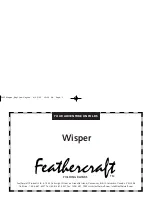
2. Your Chaparral boat has fittings for filling the fuel tank. Remove
fuel fill plate. Insert the fuel supply nozzle. Allow nozzle to stay
in contact with fitting to prevent possible static-produced sparks.
Note: The fuel fill cap has a built in tank ventilation feature. If
you should need to replace the cap, see your dealer for the
exact same cap to ensure proper fuel system operation.
3. After pumping approximately 5 gallons of fuel into tank, inspect
engine and fuel tank area for any signs of fuel leakage. Continue
fueling if you do not detect any leaks or other problems.
4. Allow space at the top of the tank for thermal expansion. Do not
overfill tank so that fuel comes out fuel tank vent.
Note: Do not over fill tank, causing fuel to spill onto water.
5. If fuel can not be pumped in at a reasonable rate, check for a
plugged fuel vent plug or kink in the line.
Post-Fueling Procedures
1. When you have finished fueling, replace fuel fill cap and wash
off any fuel spillage around fuel fill area. Discard, in a safe place,
any rags you may have used to wipe off fuel spills.
2. Open engine compartment and all hatches and compartments
closed during fueling. Inspect these areas for fuel fumes or fuel
line leakage visually and by smelling. Check out any sign of fuel
leakage or any indication of fumes and correct problem before
starting the engine.
3. Run bilge blower at least four minutes before restarting engine
to ventilate engine compartment.
OPERATING YOUR BOAT
Starting the Engine
Important: Falls from moving boats are a major cause of fatal
recreational boating accidents. Do not allow passengers to ride
on the bow with feet hanging over the side or ride while sitting
on the stern, gunwales, or seat backs. The Coast Guard con-
siders these acts to be negligent or grossly negligent operation
and prohibits them by law.
The following information is only a general guide. Chapter 4 has
specific starting instructions for boats with battery selector switches.
Detailed instructions are also in the engine owner’s manual. Be sure
to read and follow all of those instructions.
1. Secure boat to the dock or mooring slip before attempting to start
engine. Keep boat secure until engine is running and warmed up.
2. Check lubricating fluid levels. Check fuel supply to make sure
you have enough fuel for your planned excursion.
5-8
DANGER:
Gasoline vapors are highly explosive. Run bilge
blower for at least 4 minutes before starting engine. Check engine
and fuel compartments for fumes or accumulation of fuel.
DANGER: Carbon Monoxide Hazard! A cold engine pro-
duces more carbon monoxide than a warm engine. Provide
adequate ventilation in the cabin and cockpit to prevent expo-
sure and reduce the possibility of carbon monoxide
accumulation. Open all hatches, doors, windows, and side
vents to increase air movement.
Summary of Contents for 2012 H2O Series
Page 15: ...1 7...
Page 16: ......
Page 20: ......
Page 75: ......
Page 83: ......
Page 89: ......
Page 90: ...WIRING SCHEMATICS 12 12 1 H2O INST PNL PIGTAIL...
Page 91: ...12 2 H20 INST PNL PIGTAIL...
Page 92: ...12 3 H20 DECK DISTRIBUTION HARNESS...
Page 93: ...12 4 H20 DECK DISTRIBUTION HARNESS...
Page 94: ...12 5 H2O HULL DISTRIBUTION HARNESS...
Page 95: ...12 6 H20 OPTIONAL AERATOR DECK HARNESS...
Page 96: ...12 7 H2O OPTIONAL AERATOR HULL HARNESS...
















































